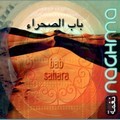For generations, the city of Guelmim has been known for its musical traditions, with songs influenced by Tamazight, Arabic and Hassaniya. It is in this artistic, linguistic and cultural richness that Saïd Tichiti was born and grew up. To him, music is a family heirloom.
«My father played in the Ganga groups and my mother in the Berber-Hassani Guedra bands, my parents were therefore my first artistic school», Saïd Tichiti proudly said.
«My five other older brothers were also very active in music, even if they were more influenced by Nass El Ghiwan and the Beatles in the 1970s», the artist explained. His four half-sisters also contribute to the artistic world of the family, by performing in all-female groups of traditional music and dance.

It is in this artistic universe that Saïd Tichiti learned percussion and songs from his earliest childhood. In nursery school, he used to perform at parties and musical afternoons. He believes that having been born in a city famous for its artistic heritage was a blessing : «Guelmim is a very eclectic city, historically, socially and musically. It is enriched by its tribal and linguistic diversity».
«We grew up in an extraordinary cohabitation and fusion, our identity is a real mosaic. In the same district, we rubbed shoulders with Amazigh-speaking neighbors, who lived right in front of Arabic-speaking families and other Hassanians, but we all understood each other and we lived in perfect harmony, without asking ourselves any questions».
Following his ancestors’ path, across the borders
After his baccalaureate, Saïd Tichiti moved to Rabat in 1991 to pursue higher education. While at the Higher Institute of Dramatic Arts and Cultural Animation (ISADAC), he rubbed shoulders with Said Bey, Driss Roukh, Samia Akariou, Salima Benmoumen and Latefa Ahrrare among others. An artistic vibe got Saïd Tichiti to be coopted by the artists for a commedia dell'arte tour:
«I was not predestined to go on stage as an actor. Besides, I specialized in cultural animation at ISADAC. But the sixth class, to which Latefa Ahrrare was taking part, needed me to replace an actor. We did two years of touring. It was a great time in my life».
At ISADAC, Saïd Tichiti also expressed his talents in cooking. With amusement, he explains that he was «the official cook for lentil and white bean soup, among [his] comrades», in a school located at the time below the Oudaya, facing the Bouregreg River in Rabat.
With his ISADAC diploma in hand, Saïd Tichiti left Morocco in 1996 for postgraduate studies in France, after receiving a scholarship issued by the French government.

A crossing point to Budapest
In Paris, Saïd Tichiti chose a course in Cultural Policy and Artistic Action. «I was very lucky because I met foreign students from the world over. I lived in a student town with a cosmopolitan atmosphere, where people from 112 countries rubbed shoulders», he explained.
«I lived in a cosmopolitan culture day and night! We were a group from Latin America and Africa; we went several times a week to the cinema and the theater. I did not evolve in an exclusively French-speaking environment», he stressed. Saïd Tichiti believes himself lucky to have had so many professional trips, which have taken him to Canada, the European Parliament or the Festival d'Avignon among others.
It is also in France that Saïd Tichiti met his wife, a Hungarian student back in the time. After earning his postgraduate degree (DESS), they settled in Budapest in 1998. The artist discovered a new universe there : «I had never considered living outside Morocco, but my fate led me to Hungary. I fell in love with Budapest from the first day, but I had a cultural shock when I arrived», he said.

The artist explained that it took him some time to overcome the language barrier. «It was difficult for me to adapt to the Hungarian language in the beginning», he acknowledged. Theater caught up with him again eventually, and allowed him to learn even faster as he had to perform roles on the local scene.
«Having lots of friends sped up my integration. With the birth of my two children, I excelled in Hungarian since I spoke it even more with them!»
A prolific musical career in Hungary
Saïd Tichiti was particularly impressed by the way, throughout the country and across all social classes, the population gives a lot of importance to artistic and sports education since childhood. In a city as open and culturally diverse as Budapest, the Moroccan artist found his place quickly.
«As a musician, it was easy for me to find artists open to different genres and able to adhere to my traditional musical universe», said Saïd Tichiti, who once rubbed shoulders with classical and jazz musicians who quickly adhered to his Amazigho-Hassani style. Thus, in 2000, barely two years after his arrival in the country, he created his band, Chalaban.
Being a melting pot of different nationalities, Chalaban aims to act as a vessel of the ancestral musical education he had been acquiring since childhood.
«I don't just play music and greet my audience before I disappear. I create a conversation with this audience; I talk to them about the origins of my music, my hometown. My performances are music with mini-conferences».
The concert was a major step in the path towards fame. «After this concert, we had invitations from all over Hungary. A year later, we released our first album». After becoming the rising star of the Hungarian music scene, Saïd Tichiti did not hesitate to share his success with his fellow compatriots by inviting Gnaoua music bandleaders. «Through my work, I encourage Hungarian programmers to integrate these artists into their events», he told Yabiladi.

Indeed, it is through Saïd Tichiti that the Hungarian public discovered Mahmoud Guinea, Hamid El Kasri or Othmane El Khaloufi. «We also took advantage of Ramadan when it coincided with other religious festivals, to invite artists of Moroccan Jewish music and gypsy troops from Hungary, in order to embody the cosmopolitanism that we live», Chalaban’s leader recalled.
As of today, Chalaban has recorded six albums and will soon celebrate its twentieth birthday : «We had planned a promotional tour for our 20 years, but because of the global pandemic, these deadlines could be postponed to 2021», explained Saïd Tichiti, full of hope.





 chargement...
chargement...













